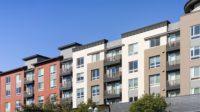With recent escalations in the frequency and intensity of hurricane events, and the catastrophic damage that results, builders must attempt to design a more durable and resilient type of construction. Over the last few years, the eastern seaboard and the gulf-facing states have endured some of the strongest recorded Hurricane winds in our nation’s history.
There is obviously a necessity for advancements in our building design. for years, the standard practice of hurricane preparedness has been limited to installation of hurricane shutters over windows, buckling down in one’s home, and waiting for the storm to pass. Though this approach will help halt flying debris from entering through your windows, it fails to address the largest susceptible area of any building, the exterior walls and roof, everywhere typically plywood and OSB are utilized.
Any wind tunnel test will prove that the introduction of hurricane force winds into any structure, causing the pressurization of the building, will inflict injury and/or damages, possibly tearing the roof off the building. Therefore shuttering the windows will add one layer of protection from flying debris, but leaves the rest of the exterior areas (walls/roof) susceptible to these airborne projectiles.
Code Overhauls
What is being done to prevent flying debris from coming through those areas? As you might imagine, Florida has one of the most stringent building codes in the nation. After Hurricane Andrew in 2002, both the state and Miami-Dade County, overhauled their respective building regulations where they could.
These code changes did address some of the major contributors to costly building damage caused by storms, but were limited to structural hardware considerations. The focus was on connections of materials to the structure via fastener upgrades, upgrading strapping and clipping hardware to help secure the roof, as well as impact resistant windows. But again, not much else was done to protect these vulnerable walls and roofs.
Standard wood framing with plywood sheathing can provide your building some wind shear protection, but wood is no match for hurricane force winds and wood sheathing will not be able to stop an airborne projectile from penetrating the wall system. Additionally, wood is very susceptible to mold growth and rot if there happens to be flooding due to these storms. This type of one-two punch leaves most dwellings uninhabitable.
Product Improvements
Luckily, the building material industry has responded with solutions to both risk factors. First, improvements have been made with the introduction of various mold resistant sheathings on the market today. Many of these sheathing products could be exposed to the elements for a given amount of time and not allow mold growth or deterioration. When combined with innovative proprietary composite structural panels solutions like Sure-Board, both risks can be vastly reduced. This type of product is not only mold resistant but also allows for the continued use of standard construction framing methods, while enhancing the hurricane protection and resiliency of your structure.
Series 200/200W are a galvanized steel sheathing product that can be used on either wood or metal framing. It is a factory produced, nationally certified composite of 22 gauge/.027 inch galvanized sheet steel laminated to any type of approved gypsum or MDF product on the market. The incorporation of this composite panel provides the builder with the ability to install the panel in one step and allows the panel to be installed tight against the framing. Having the composite panel fastened in a single sheet tight to the framing, not only reduces labor but is also the key ingredient to providing superior shear values. Third party testing and historical storm data has proven that separate installations of sheet steel and sheathing do not perform nearly as well as a single laminated sheet steel panel.
When compared with cinderblock, steel-backed sheathing over standard framing can be erected in less time and is lower cost. There is no need to build furr walls inside to accommodate plumbing and electrical, because standard framing methods continue to provide a wall cavity to house the hardware for both systems.
These composite steel-backed materials, when used on either wood or steel framing materials, have many benefits with either application. One significant benefit for their use, in combination with cold form steel framing, is that it not only gives you a structure that is Miami-Dade approved for hurricane flying debris at shelter status, but inherently gives the structure the ability to withstand the flood that could very well accompany the same storm.
Granted there will be other aspects of the house that will require repair depending on the severity of the floodwaters, but your main structure stands a much better chance of re-habitability after the storm subsides.
Hurricane Ike
A good example of such an occurrence, took place in 2008 following the wrath of Hurricane Ike.
Many of the coastline buildings were damaged beyond repair. One building that was being constructed at the time was designed with mid-rise CFS framed structure, which utilized the shear panel.
Though the building was not yet complete when the storm arrived, it was able to withstand the devastation and allowed for final completion after the storm and its aftermath had passed. Unfortunately, many other completed wood framed buildings did not fare so well and needed to be either torn down or rebuilt.
An equally important aspect to consider is the roof and floor sheathing, which also play a vital role in the structural integrity of the building. Similar to the composite panel steel laminated wall sheathing, Series 200S is a proprietary non-combustible steel backed roof and floor sheathing.
It has a 20 gauge/.033 galvanized steel sheet laminated to non-combustible sheathing, which is designed specifically for use in wet areas. The concept behind this product is to replace the current plywood/OSB roof sheathing, leaving a roof with continuous steel backing for secure attachment of any type of roofing material used on the structure, while providing a roof diaphragm that will not puncture from flying debris.
With the knowledge that frequent and powerful hurricanes are a reality for certain geographic regions of this county, third party tested galvanized steel sheet laminated to mold resistant sheathing could be your best defense and a perfect fit to incorporate into your next project. The nature of Sure-Board’s use of sheet steel could help prevent the tear out of the fasteners on the walls, as well as the roof sheathing, giving the structure a better opportunity to weather the storm.










